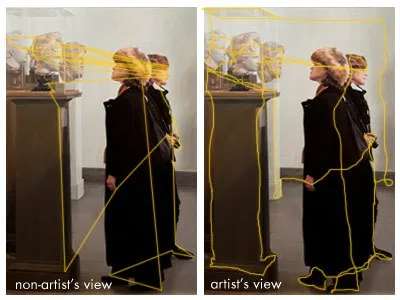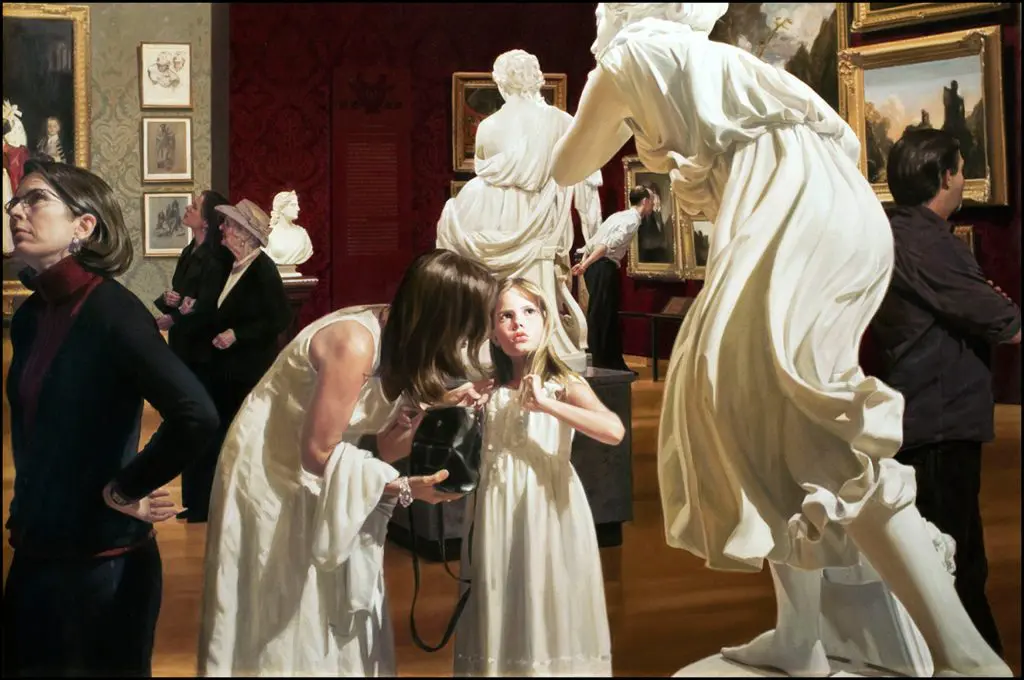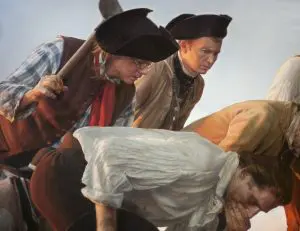If it hadn’t been for a stroke of good luck, Vose Galleries would still be continuing its ten-year countrywide search to find a world-class figure painter. As it happened, our artist in residence, Peter Greaves, was at our framer’s studio and noticed an incredible portrait by a painter totally unknown to us named Warren Prosperi. Peter was stunned by the quality, and within the week Peter and Carey Vose made a studio visit, returning to the gallery with rave reviews. Here was a world-class figural painter right in our own backyard!
For the past twenty years, Warren has been quietly living the life of a portrait painter and muralist. A single commission to paint a posthumous portrait of Dr. Tom Hackett, former head of psychiatry at Massachusetts General Hospital, lead to the commissioning of twenty one more portraits of distinguished Massachusetts General doctors, which now hang throughout the hospital. Because of this long and successful association, the hospital awarded Prosperi a major commission to paint a historical panorama of the first public demonstration of ether, marking the birth of modern surgery that took place at Massachusetts General in 1846. Unveiled in 2001, the 10 by 7 foot mural employed twenty MGH surgeons and physicians as models for the reenactment and now hangs permanently in the former surgical amphitheater.
Raised in Fort Myers, Florida, Warren began drawing at age five, when he became engrossed by artist John Gnagy’s television series of the 1950s, Learn to Draw. Later the artist spent every Saturday at the Ringling Museum of Art in Sarasota, which the artist calls his “spiritual home.” Sadly, Warren’s father died during the polio epidemic of the nineteen fifties, and Warren assumed the duties of “man of the house”. When he turned eighteen, Warren sold the family home, packed his mother and brother into their Volkswagen bus and headed for Boston, hoping to become an artist. “I wasn’t drawn by the vanguard art movements in New York City,” states the artist, “and knew Boston to be more traditional and historically inclined; the ‘Athens of the East’.” To support the family, Warren became head decorator for Filene’s department store in Belmont, MA, for four years, but the urge to paint became overwhelming.
He found inexpensive housing at the Interfaith Center on Beacon Street, cleaned and mopped floors for the Blue Parrot Restaurant in Cambridge during the early morning, then copied the old masters at the Boston Museum of Fine Arts in the afternoon for two years. “Rembrandt, Millet, Velasquez, Reubens, Chardin became my mentors”, Warren states. “Reubens sketches reveal almost everything going on in the 17th century, and he taught me how to use paint. Another great source was a book written by a restorer of old master paintings at the Louvre in the 1920s. From him I learned all the techniques and materials used in the earlier centuries.”
Warren was the personification of the starving artist at this point, but he believed, “If I keep painting, everything will be all right. Doors will open.” And open they did. Within the year, Warren would immediately become smitten with Lucia Roetter, an attractive young waitress who was working at the Blue Parrot during the summer after graduating from Hampshire College. “I pursued her like a freight train”, exclaims the artist, “and luckily she reciprocated. We’ve been together ever since.”
The couple eked out a living, but their fortunes changed when a Harvard friend showed Warren’s portfolio to the Harvard continuing education department. They subsequently hired him to teach classical drawings from plaster casts, and soon many of his students began studying with him privately at his studio from live models, affording the artist an income and time to paint. From there, Lucia began selling his work to friends and nearby businesses, and two of their earliest major collectors, Saul and Naomi Cohen of Hammond Realty, offered them their carriage house for nominal expenses in exchange for paintings. They lived there for sixteen years as Warren continued to master his craft and he and Lucia built a market for his work.
During this time he established his reputation as a portrait painter with his many commissions from Massachusetts General Hospital, and subsequently painted the portraits of Dr. Donlin Long, former chief neurosurgeon at Johns Hopkins Hospital; retired Massachusetts Senate President William Bulger; Adele Simmons, former president of the MacArthur Foundation; and Vartan Gregorian, president of the Carnegie Institute.
Also during his stay at the carriage house, Warren began his mural career, painting six murals on permanent display at the Joslin Diabetes Center, depicting the center’s history, which later lead to two murals for the lobby of the Rhode Island Hospital, one of patient care in 1886 and the other of patient care in 2005. We have had many lively meetings discussing art philosophy with Warren and his wife, Lucia, who has always played a large role as Warren’s business manager and close collaborator. It is an unusual partnership, one that combines two bright minds converging on all aspects of each painting. “Lucia and I view things both aesthetically and personally so similarly, that even our differences work to build a cohesive artistic vision,” notes Warren. Lucia continues, “I think the reason the collaboration works as well as it does is because intuitively I know where my contributions end and his easel work begins.”
Warren aligns himself with the tenets of optical naturalism, a method started by Caravaggio, perfected by 17th century masters Hals and Velasquez, and continued by late 19th century contemporaries Zorn, Sorolla, and Sargent. “This tradition examines the nature of visual experience and the structure of an actual moment,” cites the artist. Warren employs a complex set of visual inventions with a particular emphasis on light/dark contrasts. One of the artist’s current students, Dr. Alice Flaherty, a renowned neurologist and noted author at Massachusetts General Hospital, has spent many hours with Warren and Lucia trying to understand the connection between how the mind works and how it relates to paintings. Dr. Flaherty’s fascinating essay on the subject is included in this catalogue.
In preparing for this exhibition, Warren was particularly excited to find another outlet for his creativity, and began a two-year process defining his focus and preparing a cohesive body of work. Initially, the artist wanted to work on a theme similar to that of genre painting, focusing on people in the moment, reflecting both the character and environment of the subject. As he traveled around New England for subject matter, however, he rediscovered a passion for painting the landscape and decided to change the focus of his theme somewhat. He would paint two views of similar subject matter: two different images of a woman gazing at a statue in a museum, for example, or a fisherman viewed from two different angles. The result is both simple and elegant!
Warren has the rare ability to make his subjects come to life, and is an expert at facial expressions and body language. His figures are often pensive and engage the viewer in wondering what the subject might be thinking about. What are the two little girls discussing as they ponder the pounding surf? With her hands clasped, a woman gazes at a classical marble statue and appears deeply touched. The artist’s focus on moments of everyday life allows the viewer to identify with the scene, establishing a sort of intimacy. His masterful design sense, creative approach, and painstaking craftsmanship are all hallmarks of his immense talent.
“When I came to Boston in 1968, I visited Vose Galleries and was crushed that they didn’t handle living artists at that time. Now my dream of having a show here has been realized, and I am reminded of my old mantra: ‘If I just keep painting, everything will be all right. Doors will open’.” We are so pleased that this door opened into Vose Galleries.

Artists Show Us How We See
By Alice Flaherty, MD, PHD (original article appeared in Vose Galleries Catalog for “Duets, Theme and Variation”) Many conversions with Warren and Lucia Prosperi have made me fascinated with the way artists affect our perceptions and emotions. As a neurologist, I’m curious about how the brain processes visual art. Artists teach us to see the world […]

The MFA Plays An Artful Mind Game With Its Visitors — And They Love The ‘Epiphany’
Prosperi’s Museum Epiphany III is featured in the Penny and Jeff Vinik Gallery on the second floor of the Art of the Americas wing of Boston’s Museum of Fine Arts. The gallery has red Victorian wallpaper and white classical statues. Museum Epiphany III is the central painting on the gallery’s southeast wall and shows an expression of the real-time view of the gallery you are in.

Boston Globe: “Accuracy is in the details”
Prosperi painting depicts pivotal moment in the Battle of Bunker HillJuly 01, 2011|By Cate McQuaid, Globe Correspondent SOUTHBOROUGH — Through the early morning hours of June 17, 1775, American colonists dug a trench and built a wall on Breed’s Hill. As dawn broke, the British below saw the activity and lobbed cannonballs at the culprits — […]